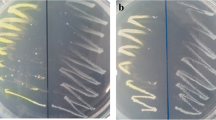Abstract
Xanthobacter 124X when grom on 4-hydroxyphenylacetate was able to hydroxylate this compound yielding homogenisate. Ring fission of this latter compound gave maleylacetoacetate which was isomerized to fumarylacetoacetate. The isomerase involved resembled maleylacetoacetate isomerases in Gram-negative bacteria in that glutathione was required for activity. Fumarate and acetoacetate were both detected as products of the hydrolysis of fumarylacetoacetate.
Similar content being viewed by others
References
Adachi, K., Takeda, Y., Senoh, S. & Kita, H. (1964) Metabolism of p-hydroxyphenylacetic acid in Pseudomonas ovalis. Biochim. Biophys. Acta 93: 483–493
Blakley, E. R., Halvorson, H. & Kurz, W. (1967) The microbial production and some characteristics of δ-carboxymethyl-α-hydroxymuconic semialdehyde. Can. J. Microbiol. 13: 159–165
Chapman, P. J. & Dagley, S. (1962) Oxidation of homogentisic acid by cell-free extracts of a vibrio. J. Gen. Microbiol. 28: 251–256
Crawford, R. L. (1976) Degradation of homogentisate by strains of Bacillus and Moraxella. Can. J. Microbiol. 22: 276–280
Crawford, R. L. & Frick, T. D. (1977) Rapid spectrophotometric differentiation between glutathione-dependent and glutathione-independent gentisate and homogentisate pathways. Appl. Environ. Microbiol. 34: 170–174
Dagley, S. & Wood, J. M. (1965) Oxidation of phenylacetic acid by a Pseudomonas Biochim. Biophys. Acta 99: 383–385
Fahey, R. C., Brown, W. C., Adams, W. B. & Worsham, M. B. (1978) Occurrence of glutathione in bacteria. J. Bact. 133: 1126–1129
Ginkel van, C. G. & Bont de, J. A. M. (1986) Isolation and characterization of alkene utilizing Xanthobacter spp. Arch. Microbiol, in press
Hagedorn, S. R. & Chapman, P. J. (1985) Glutathione-independent maleylacetoacetate isomerase in Gram-positive bacteria. J. Bact. 163: 803–805
Hagedorn, S. R., Bradley, G. & Chapman, P. J. (1985) Glutathione-independent isomerization of maleylpyruvate by Bacillus megaterium and other Gram-positive bacteria. J. Bact. 163: 640–647
Hertzberg, S. H., Borch, G. & Liaaen-Jensen, S. (1976) Bacterial carotenoids. Absolute configuration of zeaxanthin dirhamnoside. Arch. Microbiol. 110: 95–99
Janssen, D. B., Scheper, A., Dijkhuizen, L. & Witholt, B. (1985) Degradation of halogenated aliphatic compounds by Xanthobacter autotrophicus GJ10. Appl. Environ. Microbiol. 49: 673–677
Knox, W. E. & Edwards, S. W. (1955) The properties of maleylacetoacetate, the initial product of homogentisate oxidation in liver. J. Biol. Chem. 216: 489–498
Lowry, O. H., Rosebrough, N. J., Farr, A. L. & Randall, R. J. (1951) Protein measurement with Folin phenol reagent. J. Biol. Chem. 193: 265–275
Malik, K. A. & Claus, D. (1979) Xanthobacter flavus, a new species of nitrogen-fixing hydrogen bacteria. Int. J. Syst. Bacteriol. 29: 283–287
Minnikin, D. E., Alshamaony, L. & Goodfellow, M. (1975) Differentation of Mycobacterium, Nocardia and related taxa by thinlayer chromatography analysis of whole-organism methanolysates. J. Gen. Microbiol. 88: 200–204
Sparnins, V. L., Chapman, P. J. & Dagley, S. (1974) Bacterial degradation of 4-hydroxyphenylacetic acid and homoprotocatechuic acid. J. Bact. 120: 159–167
Trower, M. K., Buckland, R. M., Higgins, R. & Griffin, M. (1985) Isolation and characterization of a cyclohexane-metabolizing Xanthobacter sp. Appl. Environ. Microbiol. 49: 1282–1289
Tweelvan den, W. J. J., Smits, J. P. & Bontde, J. A. M. (1986) Microbial metabolism of D- and L-phenylglycine by Pseudomonas putida LW-4. Arch. Microbiol. 144: 169–174
Walker, P. G. (1954) A colorimetric method for the estimation of acetoacetate. Biochem. J. 58: 699–704
Wiegel, J. (1981) Distinction between the Gram reaction and the Gram type of bacteria. Int. J. Syst. Bacteriol. 31: 88
Wiegel, J., Wilke, D., Baumgarten, J., Opitz, R. & Schlegel, H. G. (1978) Transfer of the nitrogen-fixing hydrogen bacterium Corynebacterium autotrophicum Baumgarten et al. to Xanthobacter gen. nov. Int. J. Syst. Bacteriol. 28: 573–581
Author information
Authors and Affiliations
Rights and permissions
About this article
Cite this article
Van Den Tweel, W.J.J., Janssens, R.J.J. & De Bont, J.A.M. Degradation of 4-hydroxyphenylacetate by Xanthobacter 124X. Antonie van Leeuwenhoek 52, 309–318 (1986). https://doi.org/10.1007/BF00428642
Accepted:
Issue Date:
DOI: https://doi.org/10.1007/BF00428642



